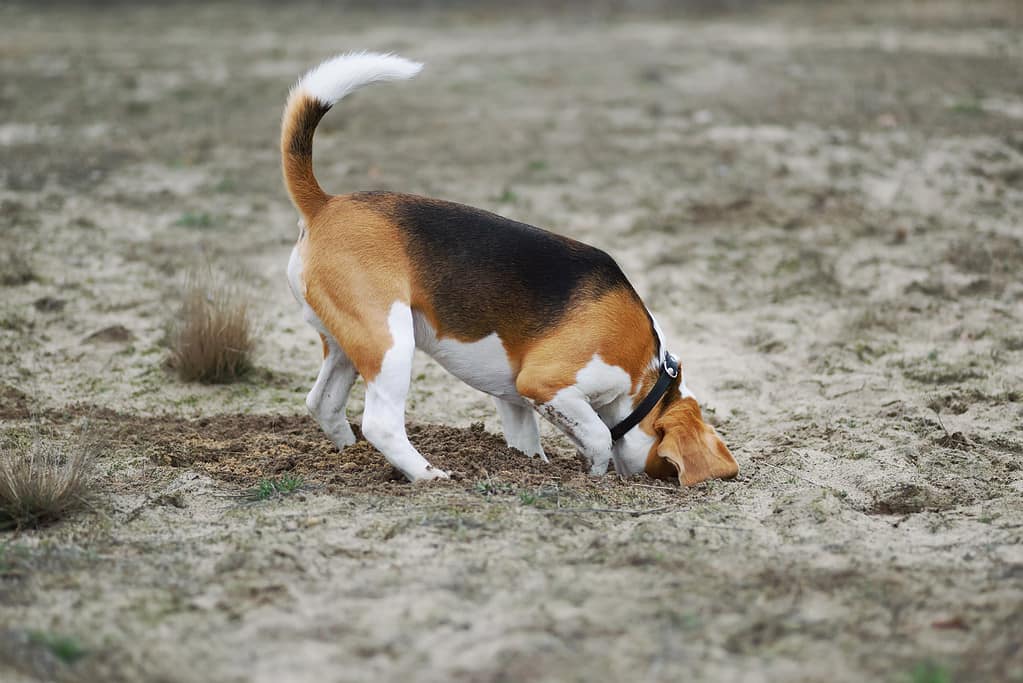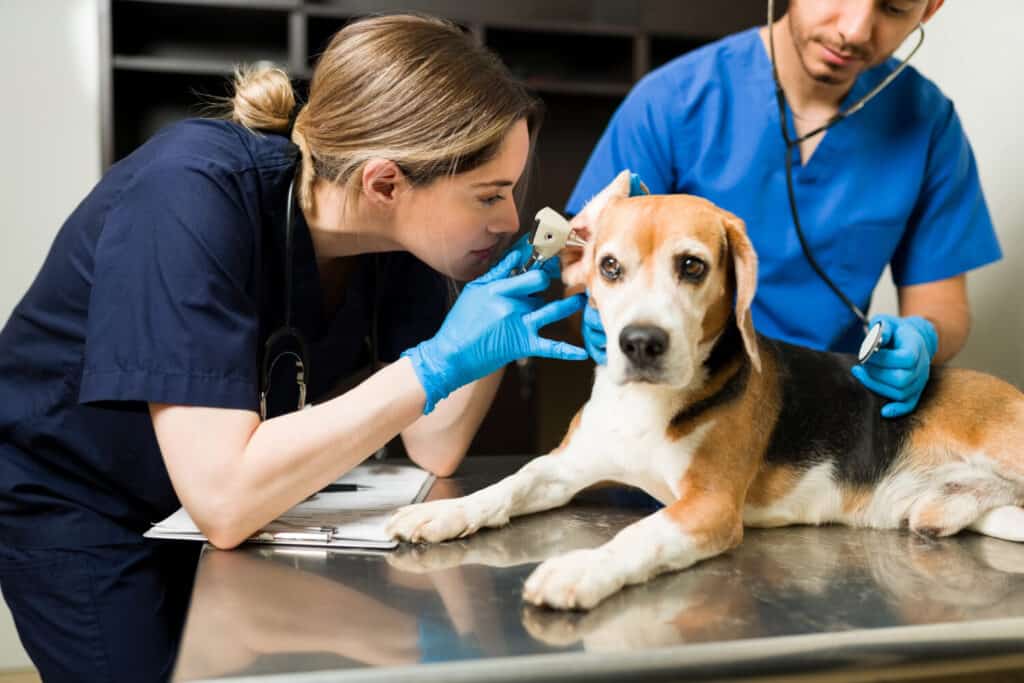Beagles are considered moderately active dogs. They are not as active as a Labrador Retriever or Cane Corso but more active than a Shih Tzu. Sadly, many dog owners do not give their beagles enough exercise, which is why they are commonly overweight. (Of course, being very food-oriented doesn’t help matters, either).
Obesity is a common health problem for this breed, so providing the right amount of exercise is essential.
That said, figuring out how much exercise your beagle needs can be challenging. That’s why we’ve provided a complete Beagle exercise plan below.
Beagle Exercise Plan

Daily walks are a must for beagles.
©Vasil Dakov/Shutterstock.com
Beagles need moderate exercise each day, which is also true for about half of all dog breeds. However, that doesn’t mean that they don’t need any exercise. While they may not be Weimaraners, your beagle still needs an exercise plan to avoid obesity.
Plan on starting with two thirty-minute walks twice a day. Your beagle should be trotting along – not walking at a leisurely pace. You can stop several times to allow your beagle to sniff around (a great activity for mental stimulation). However, when you’re moving, you should be moving.
You should also add other energetic activities to your day. Beagles need plenty of time to stretch their legs in a fenced-in area at least a few times a week. A fenced-in yard works best for this breed. However, even if you don’t have a fenced-in yard, you can meet this need by visiting a dog park a few times a week.
Beagles should never be allowed to wander around off-leash. Due to their very strong noses and tracking instincts, it is very easy for them to get on a trail and end up miles away. Beagles often don’t pay attention to where they’re going when tracking, so the odds of them finding their way back are low.
You can also try scent work, fetch, tug games, and even agility. Beagles aren’t as work-oriented as other dogs, so a quick game of fetch often works well. You don’t have to train them in a canine sport, as we recommend for other breeds.
What Happens If You Don’t Exercise Your Beagle Enough?

Beagles are prone to boredom when not properly exercised.
©Tetiana Garkusha/iStock via Getty Images
Exercise is essential for beagles. If you don’t provide them enough, they’re exceptionally prone to obesity. Beagles also like to eat, which doesn’t help matters. Too much eating and not enough exercise can quickly lead to your dog packing on the pounds.
If they gain enough extra weight, they’ll start becoming obese. Just like in humans, beagles can develop all sorts of health conditions if they become overweight or obese. Heart conditions, joint problems, and back issues are all common in overweight dogs. Beagles are already prone to some of these issues, so keeping them at the proper weight is vital.
Beagles are also prone to boredom, excess barking, and destructive behavior when not properly exercised. Often, beagles are well-behaved indoors. However, this isn’t the case when they aren’t properly exercised. They may decide that they have the energy to eat through your couch cushion or search through the trashcan.
Expect behavior problems if you don’t provide your beagle with enough exercise.
It’s harder for a beagle to control their behavior and pay attention to training (an area they already have a problem with) without proper exercise. You will need to train your beagle not to bark so much indoors or eat your couch but don’t expect much progress if your dog isn’t getting the exercise they need.
Beagles will also have a higher chance of health issues if they exercise too little. Just like a person, exercise keeps your dog’s lungs, heart, and joints healthy. Your dog is more prone to practically all health conditions without enough running around. Exercise is a must if you want your dog to live their complete lifespan!
Simply put, beagles need exercise and won’t fit well into home life without it.
Can You Exercise a Beagle Indoors?

Digging is a common problem behavior for beagles that have too much energy.
©Tetiana Garkusha/iStock via Getty Images
You can provide some exercise for your beagle indoors, such as playing fetch down a long hallway. However, there are severe limitations to exercising your beagle in such a confined space. Unlike breeds like Dachshunds and Lhasa Apsos, beagles cannot meet all of their exercise needs indoors. You will have to take them on daily walks.
Beagles were made to run, which is why we recommend at least an hour of walking each day and playtime. You can implement some exercise indoors, especially if your beagle is younger and needs more movement. You should never rely on indoor exercise alone to wear out your beagle, though.
Think of indoor exercise as a supplement – not the main event.
If you can’t or don’t want to exercise your dog outside for one reason or another, don’t get a beagle. Many small, inactive breeds can function without tons of exercise and may not require daily walks like a beagle.
That said, beagles can benefit from some indoor stimulation while you’re gone during the day. Consider investing in food puzzles and scent toys to keep your beagle busy while you aren’t around to play. When you’re home, training sessions can also be done indoors and may provide some extra stimulation.
Can You Exercise a Beagle Too Much?

A vet visit is called for if your beagle suddenly cannot exercise as much as they once could.
©Beach Creatives/Shutterstock.com
Absolutely, you can easily exercise a beagle too much. If you told a random person in the street to go run a marathon, the odds are that they wouldn’t be able to do it. In fact, it may even be dangerous for them to try!
Dogs are the same way. You cannot expect your beagle to run miles if they’re only used to walking around the block. Some beagles may not even be able to follow our exercise plan above (at least at first) if they haven’t been properly exercised for years.
Signs of too much exercise include:
- Lethargy
- Excessive panting
- Behavioral changes
- Refusal to exercise
- Muscle weakness
- Digestive problems
If you notice any of these signs, you should back off of exercise. That doesn’t mean you shouldn’t exercise your dog at all, but you should lower the amount of walking and playtime you expect.
Your plan should be to work up to the amount of exercise we suggest above. Every healthy beagle should be able to take two brisk walks each day. If they can’t, it’s a sign that they aren’t as healthy as they should be.
This unhealthiness may be caused by not getting enough exercise for too long. In that cause, you should slowly increase the amount of exercise until your dog is back where they should be.
Of course, an inability to exercise can also be caused by a range of other health problems. If your dog suddenly gets tired much easier than before, you should speak to your vet.
What about Beagle Puppies (or Seniors)?

Beagle puppies need less exercise than their adult counterparts, but that doesn’t mean you shouldn’t exercise them at all.
©NinaM/Shutterstock.com
Beagle puppies need less exercise than adults simply because their legs are shorter. Before your puppy is a year old, they should be taking shorter walks, usually around 15-20 minutes long. Start at 15 minutes for a 3-month-old puppy and slowly work up to 30 minutes by the time they reach 18 months.
Multiple short walks a day is much better than one long walk. Puppies tend to bounce back fast after a walk and can quickly become hyperactive again. Short exercise sessions can help tone down their energy.
Older dogs will slowly decrease their exercise need as they age. Very senior dogs may not be able to do more than a five-minute walk around the yard. Once your dog reaches senior age, following their cues is important. Different dogs decline in their physical abilities at different times, so we can’t give a one-fits-all suggestion.
The photo featured at the top of this post is © tetiana_u/Shutterstock.com
Ready to discover the top 10 cutest dog breeds in the entire world?
How about the fastest dogs, the largest dogs and those that are -- quite frankly -- just the kindest dogs on the planet? Each day, AZ Animals sends out lists just like this to our thousands of email subscribers. And the best part? It's FREE. Join today by entering your email below.
Thank you for reading! Have some feedback for us? Contact the AZ Animals editorial team.







